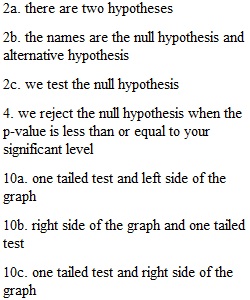


Q Name: ________________________________ Lab #8: Review of t-tests PSYCH 248 PART 1: Reviewing Research Designs. Read the descriptions of the studies below and identify the type of test statistic appropriate for each one: independent samples t, related samples t, or one-sample t. Briefly indicate why that one is appropriate and whether the hypothesis is two-tailed. Also indicate whether the test is a between or within comparison. Study 1: A research study was conducted to examine the differences between older and younger adults on perceived life satisfaction. Ten older adults (age 65-75) and 10 younger adults (age 25-35) were given a life satisfaction test. Study 2: To change the study habits of students, nine students were randomly selected to attend a Study Skills workshop. To test whether the seminar had any effect, a researcher recorded the hours per week each student studied both before and after the workshop. Study 3: You wish to determine whether a New York City charter school’s students scored higher on average than the population of NYC public school students on a standardized math exam. Study 4: At swimming meets each swimmer competes first in a “heat” and later in a “trial” for the same event (such as 100 freestyle). A high school swim coach is interested in testing her hypothesis that times are faster for the second race. Fill in Answers: Type of Test: Why? Be brief Between or Within Design? (B or W) 1-tail or 2-tails? Study 1 Study 2 Study 3 Study 4 PART 2: Test whether emotional intelligence increases from age 15 to 20. Emotional intelligence (EQ) involves the ability to read other people’s emotions and feel empathy, as well as to be aware of and control one’s own emotions. As a Developmental Psychologist you design a longitudinal study to test your hypothesis that EQ will increase with age from adolescence to early adulthood. You select a sample of 20 young men and test their EQ at age 15 and again when they are age 20. Use a t-test to see whether emotional intelligence increased significantly across time. Use the Emot Intelligence1.csv data on Bb. Your critical value is 0.05. Independent Var? Dependent Var? Correct test to use? Between or Within ? 1-tail or 2-tails? Emotional Intelligence Study Write the Hypotheses in words: 1. Null Hypotheses: ___________________ 2. Alt Hypotheses: _____________________ Download the excel file from Bb (Emot Intelligence1.csv). Open the file in JASP. • Click on “t-tests” at the top. Under “classical”, select “paired samples t-test”, Tests - Student • Move both variables into the variables box. Make sure “Age 20” variable is on the left and “Age 15” on the right. • Under Alt. Hypothesis, select “Measure 1 > Measure 2.” Under Assumption Checks select “Normality”. • On the right side, under “additional statistics” select “Location parameter w Confidence Int, Effect size.” 3. Paste the JASP results (sig table and descriptives table – not assumption test) below for this test. 4. In simple words explain what this means. Was the hypothesis supported? How much did EQ change on average? What does the Cohen’s d-value tell us? 5. Write an APA Conclusion for this test including: name of the t-test used, and APA stats including ‘d’ at then end. PART 3: Test whether emotional intelligence differs between two samples - ages 15 and 20. In another study you don’t want to wait 5 years so you decide to compare Emotional intelligence (EQ) scores of a sample of boys (age 15) and another sample of young men (age 20). You are still testing the hypothesis that EQ will be higher in the older group than in the younger adolescent group. Use the proper t-test to see whether emotional intelligence is significantly higher in the older group. Use the EQ Groups.csv data on Bb. Your critical value is 0.05. Independent Var? Dependent Var? Correct test to use? Between or Within ? 1-tail or 2-tails? Emotional Intelligence 2 group study Write the Hypotheses in words: 1. Null Hypotheses: ___________________ 2. Alt Hypotheses: _____________________ Download the excel file: EQ Groups.csv and notice how the data are organized. Open the file in JASP. Add value labels for the two groups: 1 = Age 15, 2 = Age 20. To Run the t-test: • Click on “t-tests” at the top. Under “classical”, select “independent sample t-test.” • Move your dependent variable into the variables box. • Move your independent variable into the “grouping variable” box. • Under Alt. Hypothesis, select “Age 15 < Age 20.” • On the left select both assumption checks (Normality & Equal variances) • On the right select “Location Parameter, Effect size (Cohen’s d), Descriptives, Descriptives plot” 3. Paste the JASP results below for this test. (1-tailed Sig table with d, Descriptives, plot) 4. Is it significant? Write an APA Conclusion including the name of the t-test used to report results of this test. 5. Run it again but change the Alt Hyp to make it a two-tailed test. How does it change the p-level and the significance? 6. Now compare the two data files (part 2 & 3). Yes, the data are the same, but the designs are different. How did that influence the sample size, the significance, results? Why? Briefly summarize major advantages and disadvantages of repeated-measures or within-subject designs. 7. Advantages: __________________________________________________________________________ 8. Disadvantages: ________________________________________________________________________ 9. Which test has more power – makes it easier to find a significant difference – related-t or independent samples t? 10. Which test has more power – a one-tailed (directional) test or a two-tailed test?
View Related Questions